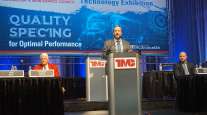Five Questions With Kerry Stritt, VP of Fleet Services for Southeastern Freight Lines

[Find the latest in equipment & maintenance: Explore this quarter's issue of Calibrate.]
What are the top maintenance-related challenges at Southeastern Freight Lines and how are you working to overcome them in your position as head of fleet services?
Technician shortage: The shortage of skilled technicians is every bit as bad as the driver shortage and in many areas of the country it is worse. Just to become a diesel technician apprentice requires 12-18 months of schooling as well as a minimum of $3,000 worth of tools and a continued investment in education and tools.
Due to the time and tool commitment, becoming a technician is not normally a midlife career change someone makes. We either get them early and help develop them or they are lost to other occupations. Having competitive pay and benefits, a clean organized workspace, ongoing training and a great company culture are keys to attracting and retaining technicians.
More Q1 Calibrate
►Preventive Maintenance Keeps Mobile Air Conditioners Humming
►Trailer GHG Ruling Muted by California Rules, Industry's Direction
►Freeze: New Year, Used Trucks
►TMC Corner: TMC Eyes Automated Driving Systems
►Baxter: Mack, Military Team Up on Combat-Ready Dump Truck
Explore the Issue!
We have implemented Lean Principles in our 27 shops and also created better start times by creating more day shift hours while reducing second- and third-shift work. We are working closely with tech schools and offering part-time flexible schedules to students.
We also anticipate creating our own tech development program in the next 12 months.
Training/Complexity of Equipment: Each year, all of our equipment gets more sophisticated and more complicated to repair. Being able to use OEM software has been a requirement for tractor work but it is now common with forklifts and trailers. The addition of telematic devices, collision mitigation systems, sensors and engine programming/troubleshooting require huge amounts of training. Proper utilization of a “test light” used to be the norm but now technicians need to understand voltage drops, 2- and 3-wire sensors, Ohm’s law and many other principles of electricity. Extensive ongoing electrical training will be critical to reducing downtime and overall cost-per-mile.
We have partnered with our OEMs and they provide extensive training to our technicians. The OEMs along with our manager of training and development conducted over 8,500 hours of hands-on training in 2021. This equates to roughly 21 hours per tech. We see this doubling and tripling over the next five years. We have worked hard over the past five years to simplify our fleet by reducing the number of different OEMs. As an example, in 2022, our trailer fleet which numbers around 11,000 will be one OEM. Our forklift fleet which numbers about 1,200 units is already 90% one OEM and moving toward 100% within three years. Our engine and transmission platform is heading in the same direction. This helps expedite training, parts utilization and product knowledge. Simplification is critical.
What is your philosophy in leading your group of technicians?
Our philosophy revolves around culture, quality and financial strength. Having a great work culture in the shop makes it easier to produce quality results. As we produce quality results it is easier to create financial strength. We want to be the employer of choice as it relates to power and trailer technicians.
How does your team use technology and management software to operate more efficiently?
We recently upgraded our maintenance software from an old legacy system to the very powerful Cetaris Fleet assist program. With just a few clicks of the mouse we can get any data we need and dump it into charts or spreadsheets. It helps us with warranty recovery, parts costs, SRT compliance as well as developing data for predictive maintenance. We also use all of the OEM-provided software and have over 90 laptops/desktops in our 27 shops. Our technicians spend almost as much time with a mouse as they do with a wrench.
In the midst of supply chain shortages, are you encountering any challenges related to procuring aftermarket parts? If so, how can the industry assuage those concerns?
We seem to have some type of weekly parts disruption but nothing that has created additional downtime. It is more the shortage of the week than anything chronic. We have stockpiled some critical parts and our OEMs have helped us with a few critical downed truck scenarios but so far it is just more challenging. Our bigger issue has been getting new equipment, especially tractors. Plant shutdowns due to COVID outbreaks and parts shortages have become the norm. The key is having great vendor relationships and managing parts effectively.
How do you envision the fleet maintenance and repair environment for commercial trucks evolving in the next five to 10 years?
The issues we currently face will just continue to become more challenging such as technician shortage and training. Understanding of electrical systems, wiring harnesses and proper diagnosing will replace aftertreatment as our biggest challenges.
Want more news? Listen to today's daily briefing below or go here for more info:





